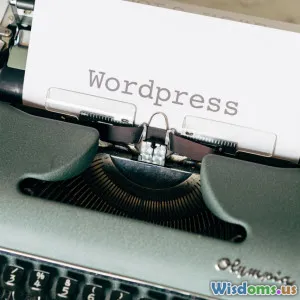
Comparing the Best Writing Software on the Market
8 min read Explore detailed comparisons of top writing software to find the perfect tool that boosts your creativity and productivity. (0 Reviews)
Comparing the Best Writing Software on the Market
In a digital age where almost every writer relies on technology to draft everything from novels to blog posts and academic papers, choosing the right writing software can be the difference between struggling with formatting and focusing entirely on your creativity. But with so many options available, how do you determine which tool fits your needs best? This article dives into an in-depth comparison of some of the most popular writing software on the market, highlighting their strengths, weaknesses, and ideal user profiles so you can write smarter, not harder.
Why the Right Writing Software Matters
Writing is not just about putting words on a page but about organizing ideas, structuring narratives, and revising efficiently. Writing software today offers features far beyond simple typing – including seamless cloud syncing, collaboration capabilities, distraction-free environments, version control, and powerful formatting tools. According to a 2021 survey by the Authors Guild, authors who integrate specialized writing software see a 25% increase in draft completion rate and a notable improvement in editing speed.
With these advancements, the software you choose can significantly influence your workflow, output quality, and motivation.
The Contenders: Top Writing Tools Reviewed
1. Scrivener
Overview: Scrivener has long established itself as the go-to app for authors tackling complex projects like novels, screenplays, or academic theses.
Key Features:
- Organizational tools including corkboards and outliner views.
- Robust support for long documents with hierarchical file structures.
- Integrated research binder to store notes, images, and PDFs.
- Export options for multiple formats like ePub, Kindle, and PDF.
Strengths: Scrivener excels in managing large projects by allowing writers to break their work into manageable sections. For example, author Joanna Penn has credited Scrivener with helping her manage the complex structure of her thriller novels effortlessly.
Limitations: A steeper learning curve and interface that can feel overwhelming for beginners.
Best For: Novelists, researchers, and anyone dealing with extensive documents.
2. Microsoft Word
Overview: A household name, Word remains a ubiquitous choice for writers in business, academia, and publishing.
Key Features:
- Advanced formatting and styling tools.
- Collaborative editing via OneDrive.
- Track Changes and commenting features for peer review.
Strengths: Its extensive feature set and compatibility ensure clients and editors can open and review files without hassle. Plus, the Track Changes feature has become an industry standard in manuscript editing.
Limitations: Can be resource-heavy and lacks specialized writing project organization tools.
Best For: Academic writing, professionals, and those requiring robust document formatting.
3. Google Docs
Overview: An online word processor centered around cloud collaboration.
Key Features:
- Real-time collaboration with commenting and suggestions.
- Version history to track document changes.
- Accessible on any device with internet.
Strengths: Teams and co-authors can simultaneously work on manuscripts, making it ideal for collaborative projects or editorial workflows. For example, journalists frequently use Google Docs to meet tight publishing deadlines working remotely.
Limitations: Limited offline functionality and fewer formatting options compared to desktop alternatives.
Best For: Collaborative workflows and writers needing mobility.
4. Ulysses
Overview: Ulysses combines a clean, distraction-free writing environment with powerful markdown-based text management.
Key Features:
- Markdown support for quick formatting.
- Goal-setting tools including word count targets.
- Sync via iCloud across Apple devices.
Strengths: Its minimalist interface helps writers maintain focus and produce clean, export-ready text. Notably, fiction author Claire Fuller has praised Ulysses for its simplicity and ability to structure short story collections.
Limitations: Apple device exclusivity limits accessibility.
Best For: Mac and iOS users seeking distraction-free environments.
5. Hemingway Editor
Overview: More than just a word processor, Hemingway Editor is designed to enhance readability and clarity.
Key Features:
- Highlights complex sentences and passive voice.
- Readability scoring to meet different audience levels.
- Emphasizes concise, clear writing.
Strengths: Its ability to train writers in clear communication has made it popular among bloggers and marketers. Writers aiming for impactful prose benefit from its instant feedback.
Limitations: Not designed for long projects or extensive formatting.
Best For: Blog posts, marketing copy, and anyone looking to sharpen writing style.
How to Choose the Best Writing Software for You
Assess Your Writing Needs
Are you creating long-form fiction or short business communications? Do you need offline access or is cloud syncing essential? For complex projects, software like Scrivener shines, while quick drafts or collaborative documents might be better suited to Google Docs.
Consider Workflow and Ecosystem
Integration with your devices and ease of export matter. For example, Microsoft Word’s widespread acceptance in publishing ensures seamless submissions, while online platforms facilitate teamwork.
Trial Before Commitment
Many programs, including Scrivener and Ulysses, offer free trials. Spending a week using a tool will reveal whether its workflow aligns with how you write.
Real-World Insights
In a 2023 author roundtable by Writer’s Digest, novelist Michael Levy shared, “Scrivener streamlined my workflow by letting me shuffle chapters effortlessly, which paper-based methods couldn’t match.” Meanwhile, editor Jessica Nguyen voiced preference for Google Docs during collaborative projects: “Real-time edits save histons of email back-and-forth." This peer feedback amplifies understanding beyond specs and feature lists.
Conclusion
There is no universal "best" writing software. Instead, your ideal tool depends heavily on your writing style, project complexity, and collaboration needs. Scrivener leads for organization in long projects, Microsoft Word dominates in formatting and professional standards, Google Docs excels at teamwork and accessibility, Ulysses offers focused minimalism for Apple users, and Hemingway Editor refines clarity. By evaluating your requirements and experimenting with these options, you’ll unlock a productive writing process tailored to your creative goals. Take the plunge today—embrace a tool that elevates your writing craft.
References:
- Authors Guild 2021 Survey: Impact of Writing Software on Productivity
- Writer’s Digest 2023 Author Roundtable Insights
- Joanna Penn, "How Scrivener Changed My Writing Life"
Rate the Post
User Reviews
Popular Posts





















